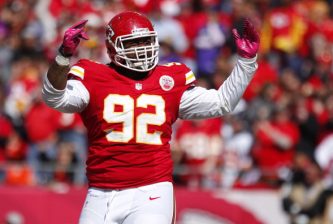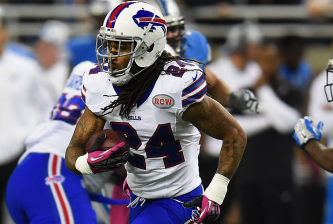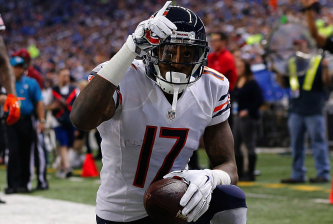Vernon Adams Jr. Oregon (2nd Round)
For a number of odd reasons, Adams had been swept under the rug for most of the draft process. Seeing as he was an FCS transfer whose job was to replace Heisman winner and No.2 overall pick Marcus Mariota, it made sense that he was brushed aside. Adams was also targeted by a former Eastern Washington teammate in Oregon’s 2015 debut. The cherry to top it all of is that Adams only checks in at about 5’10”-5’11”, immediately leading many to think he can’t play the position because he does not look the part.
The non-play factors should not be taken so seriously when Adams can, in fact, play. Adams plays with that instinctive, mobile point-guard style that passers such as Drew Brees, Tony Romo and Tyrod Taylor are known for. Like the rest of those passers, Adams does not possess elite arm strength, but he does have enough velocity to keep himself out of trouble and has the ball placement to truly threaten defenses. More specifically, Adams throws a great deep ball, displaying a solid combination of velocity and arc to place the ball just over defenders and into his receiver’s hands.
Adams can make plays with his feet, too. He is an athlete that is quicker than he is fast, but is plenty athletic enough to be a threat to move the sticks with his legs. Though, Adams is much more inclined to use his feet to find space in the pocket or create extra time out of the pocket. Despite the label he gets as a running quarterback, he amassed just under 200 yards rushing on the year, which is nothing to run home about. He is a controlled, patient mover that more often uses his feet like a boxer setting up a hay-maker with a few jabs rather than using his feet as the threat.
He can operate within the structure of the offense in compliment to his off-script ability. Adams is clearly more comfortable making backayrd football style of plays, but he can drop back and throw on rhythym with accuracy, too. His issue, more than anything, is that sometimes he can get too caught up in the moment and force a mistake in an effort to be Superman. He is not a special quarterback prospect, but he can step in an have a Tyrod Taylor-like impact right away.
Connor Cook, Michigan State (2nd Round)
Sort of like Adams, Cook has been brushed aside because of perceived issues that are not related to his play. Many are worried that Cook is a prima donna. His “trophy snatching” fiasco with Archie Griffin only worsened his image, even if the incident was entirely accidental. The fact of the matter is a lot of quarterbacks have a prima donna feel to them. Tom Brady and Philip Rivers come to mind. People should not let that attitude take away from Cook’s play.
Cook is a gunslinger through and through. He is the most aggressive passer in the class, but that is not to say he is not a smart passer. In fact, quite the opposite. Cook was asked to do more than any other passer in the class and understood how to execute his offense very well, but he opted for the big play more often than not. Cook loves to throw the ball down the field and give his receiver a shot at the ball, which was a largely successful strategy for him at Michigan State.
As is needed from the quarterback position, Cook was often impressive in crucial situations when his team needed him. The interception against Alabama is imprinted in everyone’s mind, but prior to that final game, Cook had a career of great 4th quarter play. In 2015, he rallied a 21 point comeback against Baylor and, in 2016, orchestrated an 88 yard drive to win the B1G Championship- and those are just two of his handful of impressive late wins.
Cook does have some overall accuracy concerns and can be a bit quick to fire if he sees pressure, but at the same time, he showed improvement in both areas every year he played. Cook has the mental prerequisite, arm and big throw ability to be an adequate starter in the NFL.
Trevone Boykin, TCU (3rd Round)
There may not be a more entertaining quarterback in the class than Boykin. He has electric athleticism with an arm to match. Boykin’s ability to create explosive plays, either with his legs or his arm, is unparalleled in this class. Defenses struggle wrapping him up inside and outside of the pocket, and defensive backs are often left helpless with the way he can throw down the field. He is the true definition of a playmaker.
Boykin is not unskilled in the pocket, though. He has a tendency to fire without regard for the consequences from time to time, but he is largely a more impressive pocket passer than given credit for, especially in terms of fitting tight windows. Th zip he can put on the ball allows him to make wild throws, like splitting three defenders over the middle of the field at once, on occasion.
It would be nice to see Boykin transfer his weight more consistently when throwing down the field and be a little less aggressive, but with impressive playmakers, taking those bad plays with the good is often a fine trade off. Boykin is the perfect quarterback to stash for a few years and rollout once the current starter becomes injured, moves on or retires.
Cardale Jones, Ohio State (3rd Round)
Jones is enigmatic. He was the third string quarterback for Ohio State entering the 2014, but a slew of injuries put him at the helm of the offense by the time the B1G Championship rolled around. To the surprise of many, Jones played very well and Ohio State crushed Wisconsin. Then, the next week, Jones topped himself with a quality performance and win over Alabama. To top it off, Jones helped Ohio State beat Oregon in the National Championship, finishing one of the most unlikely quarterback success stories in recent memory. He was a complete afterthought prior to the season, only to lead the team through three major games and win the National Championship.
Jones’ massive arm and ability as a blunt trauma runner allowed Ohio State to tweak their offense into something that defenses weren’t necessarily seeing on tape prior to Jones being the quarterback. He was able to open up down field concepts and make incredible use of wide receiver Devin Smith, who is now on the New York Jets. Likewise, Jones’ deep passing forced defenses to be weary of being beat over the top, softening up defensive fronts for superstar running back Zeke Elliott. He added a play making presence that Ohio State did not previously have at quarterback.
The problem was that that was not what Urban Meyer wanted in 2015. Jones got the starting job to start 2015, but when he did not light up teams in quite the same fashion as before (which should have been somewhat expected, it was a hell of a run), Meyer pulled him in favor of JT Barrett. Barrett gave Meyer the “yes man” presence at quarterback that he so dearly loves. Jones’ 2015 season is essentially throw away material because it is hard to make sense of any of it. At the same time, basing an entire evaluation off of a small handful of games from a year before his draft year is tough to do. Jones has talent, that much is certain, but whether or not he has truly harnessed that talent for the long run is left to be determined.




